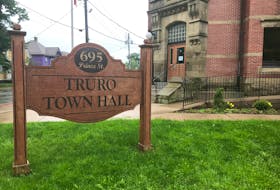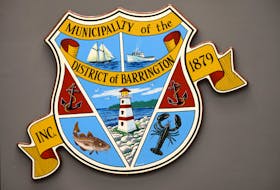Nova Scotia forests have never looked more beautiful than this past fall.
Held off by the unseasonably warm weather, when the leaves began their yearly transformation it was almost instantaneous. Brilliant deep reds and oranges popped among the thousands of trees, tempered only by muted yellows and greens that seemingly flowed endlessly across the hills and valleys of the province.
But beneath these picture-perfect giants, lies a minute, almost undetectable insect known as the hemlock woolly adelgid (HWA).
Less than 1.5 millimeters long, the HWA is capable of wiping out an entire forest of massive hemlock trees — and all in a matter of just a few years.
But one man is on a mission to bring awareness to the issue, if for no other reason than to slow the inevitable.
This past summer, Tom Rogers, South Shore resident and concerned advocate for at-risk Nova Scotia forests, launched an awareness project — Giants of Nova Scotia.
The idea for the project, which involves a 2019 calendar depicting some of the provinces most beautiful trees, came to him while walking through the “stunning trees” on his own property, he says.
“If the HWA makes its way here, for me personally, it would be an ecological disaster. This is hemlock country,” Rogers adds.
Like many of the non-native destructive species that end up Nova Scotia, HWA was first introduced into Virginia State from Japan around 1950, where it spread across the northeastern U.S.
The aphid-like insect kills hemlock trees by feeding on their nutrient- and water-storage cells at the base of the trees’ needles. In July 2017, HWA was first detected in Yarmouth and to put this into perspective, Rogers says, “In North Carolina, they have hemlock forests that have been completely wiped out in one fell swoop — just five years from start to finish.”
While some may feel this is just another alarmist issue, Rogers says the HWA has now been identified in Kejimkujik National Park, so it is already making its way east. And all it takes for the HWA to hitch a ride to other forests in the province is a single piece of firewood, he adds.
The insect hides out in the bark of hemlocks trees, so when someone brings an infect piece of wood to their campsite, for example, they are unknowingly spreading the infestation. His 2019 Giants of Nova Scotia calendar is meant to keep that message in the forefront.
Apart from raising money for the Mersey-Tobiatic Research Institute, a non-profit, cooperative research institute in Queens County, looking at the astounding beauty that is our forests day-in and day-out over the year, is a gentle reminder we can all do our part to bring awareness to the situation, explains Rogers.
After vetting more than 300 photo submissions, Rogers said they picked 13 to represent the thousands of trees that grace this province.
With the help of Anna Nibby-Woods, a veteran Mi’kmaq graphic designer, Rogers printed 1,000 calendars, more than 200 of which were pre-sold.
“My motivation, more than anything, has been to get the word out about HWA because it is something we are going to have to learn to live with. The fact is the hemlock bug is only one of the destructive bugs that can affect our forests — a new one has just been found in Bedford that affects ash trees,” says Rogers, referring to the emerald ash borer (EAB).
Like the HWA, the EAB likely arrived on a pallet from China and made its way east, first spotted in Ontario and then Quebec, where it spread to New Brunswick and now, Nova Scotia in just a matter of a few years, according to Rogers.
“This is actually a worse story than the HWA, as it (EAB) has a 100 per cent mortality rate for these trees,” he says.
Because ash trees are in most cities and urban areas, there will likely be more awareness than the HWA issue, as the destruction will be in plain sight.
“Since the emerald ash bore causes complete annihilation of the ash trees, this will be a significant loss to our cities and urban areas where these tress are prominent,” says Rogers. “Not only does it kill the tree, but these bugs essentially bore underneath the tree, creating a tunneling effect that makes the tree unstable, so from a liability standpoint, cities will have to start removing the trees for safety reasons,” he adds.
For the city of London, Ontario, that meant clearing the entire city of infected ash trees, which also meant the people of the city of London were faced with footing the bill to remove more than 10,000 ash trees, according to Rogers, which does not include the tens of thousands of ash trees in city-owned woodlands or the hundreds of thousands of trees on private property.
“We are at a point in history where we are going to have to learn find a way to adapt to this new threat. While it is great to be able to travel or just jump in our cars and go camping for a weekend, we are also going to have to be cognizant of what that means from an environmental aspect,” says Rogers.
This time of year, he says people need to be especially aware of the possibility of contamination as firewood arrives for another winter heating season. While larger businesses are more aware of the issue and will not typically sell hemlock, it is also up to the public to be vigilant, says Rogers.
“People can help by asking companies that deliver their firewood if they use hemlock and if so, are they aware of the situation and are they doing anything about it,” explains Rogers.
To date, Rogers has sold more than 600 calendars, which are $15 or $18 shipped anywhere in Canada, with all proceeds going to the Mersey-Tobiatic Research Institute. You can learn more or purchase one at giantsofnovascotia.com. You can also email Rogers at [email protected] or drop by the Alderney Landing farmers market on Dec. 8.








